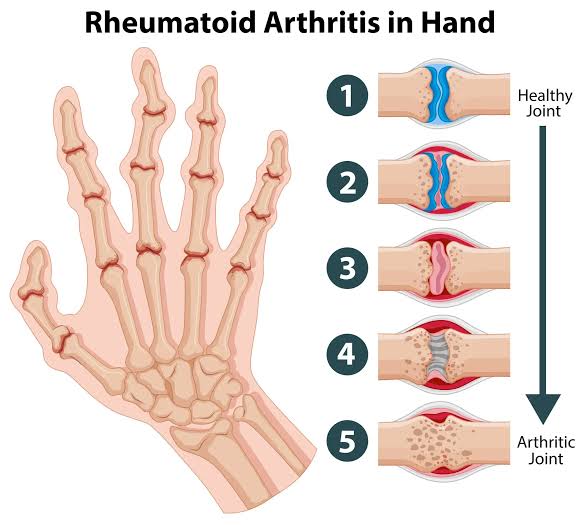Rheumatoid Arthritis: Symptoms, Causes, Diagnosis, and Advanced Treatment Approaches
Rheumatoid Arthritis: Symptoms, Causes, Diagnosis, and Advanced Treatment Approaches
Rheumatoid arthritis (RA) is a chronic autoimmune disease that primarily attacks the joints, leading to persistent inflammation, pain, and progressive joint damage. Unlike osteoarthritis, which results from wear and tear, RA stems from an overactive immune system mistakenly targeting the body’s own tissues. If left untreated, this inflammatory condition can extend beyond the joints, affecting vital organs such as the heart, lungs, and eyes.
In this comprehensive guide, we delve into the latest medical insights on RA, offering an authoritative resource on its symptoms, causes, diagnosis, treatment options, and strategies for long-term management.
Recognizing the Symptoms of Rheumatoid Arthritis
The clinical presentation of RA varies, but hallmark symptoms typically include:
1. Persistent Joint Inflammation and Pain
- RA commonly begins with swelling, tenderness, and warmth in small joints, such as the fingers and wrists.
- As the disease progresses, larger joints like the knees, elbows, and shoulders may become affected.
- The inflammation is typically symmetrical, meaning both sides of the body experience similar joint involvement.
2. Morning Stiffness Lasting Over 30 Minutes
- A distinguishing feature of RA is prolonged stiffness after waking or following periods of inactivity.
- This stiffness can significantly impact mobility and daily activities.
3. Systemic Symptoms Beyond the Joints
- Fatigue, fever, unintended weight loss, and general malaise are common.
- In advanced cases, inflammation can extend to the eyes (leading to dryness and irritation), lungs (causing breathlessness), and heart (increasing cardiovascular risk).
RA is characterized by flare-ups (periods of heightened symptoms) and remission phases, where symptoms temporarily subside.
What Causes Rheumatoid Arthritis? Unraveling the Risk Factors
While the exact cause of RA remains elusive, research suggests a combination of genetic susceptibility and environmental triggers plays a crucial role.
1. Genetic Factors
- Individuals with the HLA-DRB1 gene variant have an increased risk of developing RA.
- Family history can also heighten susceptibility, though RA is not strictly hereditary.
2. Environmental Triggers
- Smoking: The strongest environmental risk factor, smoking doubles the risk of developing RA and exacerbates its severity.
- Infections: Certain viral and bacterial infections may activate an abnormal immune response.
- Hormonal Influences: Women are three times more likely to develop RA than men, suggesting estrogen may play a role.
3. Age and Lifestyle Factors
- RA most commonly develops between the ages of 30 and 50, but it can occur at any age.
- Obesity and poor diet may contribute to inflammation and worsen disease progression.
Diagnosis: How Rheumatoid Arthritis is Identified
An early and accurate diagnosis is crucial to prevent irreversible joint damage. Physicians employ a multifaceted approach that includes:
1. Clinical Examination
- A thorough assessment of joint pain, swelling, stiffness, and range of motion.
- Pattern of joint involvement and history of symptom progression.
2. Laboratory Tests
- Rheumatoid Factor (RF) and Anti-Citrullinated Protein Antibodies (ACPA): These autoantibodies are present in up to 80% of RA patients.
- Erythrocyte Sedimentation Rate (ESR) and C-Reactive Protein (CRP): Indicators of systemic inflammation.
3. Imaging Studies
- X-rays: Detect joint damage in later stages.
- Ultrasound and MRI: Identify early signs of synovitis (joint lining inflammation) and erosion.
Cutting-Edge Treatment Strategies for Rheumatoid Arthritis
Managing RA requires a personalized approach that aims to control inflammation, relieve pain, and preserve joint function.
1. Medications
a) First-Line Treatment: Disease-Modifying Antirheumatic Drugs (DMARDs)
- Methotrexate: The gold standard for RA treatment, slowing disease progression.
- Leflunomide, Sulfasalazine, and Hydroxychloroquine: Alternative options for early intervention.
b) Biologic and Targeted Synthetic DMARDs
- TNF Inhibitors (Etanercept, Adalimumab, Infliximab): Block inflammatory cytokines.
- JAK Inhibitors (Tofacitinib, Baricitinib): Disrupt immune signaling pathways.
- These advanced therapies are used in cases where traditional DMARDs fail.
c) Symptomatic Relief: NSAIDs and Corticosteroids
- Nonsteroidal Anti-Inflammatory Drugs (NSAIDs) alleviate pain and stiffness but do not halt disease progression.
- Corticosteroids offer rapid inflammation control but require cautious use due to long-term side effects.
Surgical Interventions: When is Surgery Necessary?
In cases of severe joint damage, surgical intervention may be recommended:
- Synovectomy: Removal of inflamed joint lining.
- Joint Fusion (Arthrodesis): Stabilization of severely damaged joints.
- Total Joint Replacement: Hip, knee, or shoulder replacement in advanced RA cases.
Managing Rheumatoid Arthritis Through Lifestyle and Natural Remedies
While medications are essential, lifestyle modifications can enhance treatment effectiveness:
1. Regular Exercise and Physical Therapy
- Low-impact activities like swimming, yoga, and tai chi improve flexibility and reduce stiffness.
- Strength training helps support affected joints.
2. Anti-Inflammatory Diet
- Omega-3-rich foods (salmon, flaxseeds) reduce joint inflammation.
- Antioxidant-rich vegetables (spinach, berries) counteract oxidative stress.
- Turmeric and ginger have natural anti-inflammatory properties.
3. Stress Management Techniques
- Mindfulness, meditation, and breathing exercises reduce stress-induced flare-ups.
- Adequate sleep is vital for immune system regulation.
4. Smoking Cessation and Weight Management
- Smoking accelerates disease progression and lowers treatment efficacy.
- Maintaining a healthy weight reduces joint strain.
Complications of Rheumatoid Arthritis: What You Need to Know
If not properly managed, RA can lead to serious health complications:
- Joint Deformities and Disability: Persistent inflammation can cause irreversible damage.
- Cardiovascular Disease: RA patients face a 50% higher risk of heart attacks and strokes.
- Lung Disorders: Increased risk of interstitial lung disease.
- Osteoporosis: Certain RA medications can weaken bones, increasing fracture risk.
Taking Control of Rheumatoid Arthritis
Early intervention is the key to managing rheumatoid arthritis effectively. A combination of medications, lifestyle changes, and personalized medical care can significantly improve quality of life and prevent long-term complications.
By staying proactive, consulting a rheumatologist, and adopting a holistic treatment approach, individuals with RA can maintain mobility, reduce pain, and lead fulfilling lives.
For those newly diagnosed, seeking specialized care and staying informed are critical steps in navigating the challenges of rheumatoid arthritis.






Comments
Post a Comment